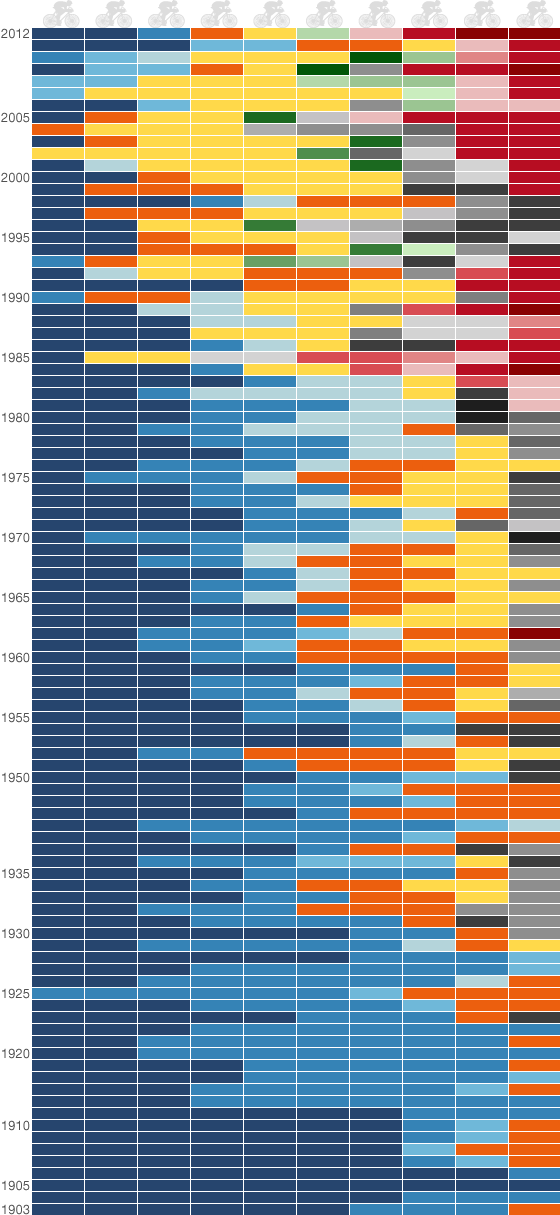Tour de France: Bradley Wiggins ends UK's long wait
- Published
Bradley Wiggins has become the first British winner of the Tour de France - but English speakers, from the US, Australia and Ireland have figured on the podium regularly in recent years. Scroll down to see the dominance of France and Belgium in the first half of the race's 99-year history.

Riders in the top 10 by country

Wiggins' previous best was fourth in 2009. Not shown on this chart is the success of Mark Cavendish, winner of 23 Tour stages and, in 2011, the first Briton to win the Tour's sprinting prize - the green jersey.Spanish riders dominate the top 10 in the noughties - though the US's Lance Armstrong breaks all records with seven wins from 1999 to 2005. A bad period for the French.Second to Lance Armstrong on three occasions, Jan Ullrich becomes the only German winner in 1997. He also wins the climber's polka dot jersey three times (1996-98).Spain's Miguel Indurain (a hero of Wiggins' youth) wins five consecutive Tours from 1991 to 1995. Riders from the ex-Communist bloc start making the top 10 from 1993 on.The first wins for English-speakers come in 1986 (Greg LeMond of the US) and 1987 (Ireland's Stephen Roche). LeMond goes on to win twice more, while Roche's compatriot Sean Kelly wins the green jersey four times. Robert Millar is the first Briton to win a jersey - the climber's polka dot jersey - in 1984.France's Bernard Hinault wins five times between 1978 and 1985 - matching the French record set by Jacques Anquetil 20 years earlier. No French rider has won since.The legendary Eddy Merckx ushers in a period of Belgian dominance by winning the Tour, and the green and polka-dot jerseys, in 1969. Five Belgians make the top 10 in 1970. Merckx wins four Tours on the trot and Belgians end up with the sprinter's green jersey eight years in a row.In 1962, Tom Simpson becomes the first English-speaker to finish in the top 10, coming in sixth after a crash on the last mountain descent. He is also the first Briton to wear the leader's yellow jersey (for one day). Five years later, he becomes the second cyclist to die while racing in the Tour.A UK team enters the Tour for the first time in 1955, paid for by bicycle company Hercules. Two of 10 riders finish.The 1950s are a great decade for France, with five wins, and six top-10 places in 1953, and again in 1954.As the Tour resumes after a seven-year break during World War II, Italian cyclists are on form, winning in 1948, 1949 and 1952. An Italian leads in 1950 too, until a French mob attacks members of the Italian team and they all withdraw.Belgian cyclists win in 1935, 1936 and 1939 and one is leading in 1937, until the team quits in protest at alleged cheating by France's Roger Lapebie, who goes on to win.The first non-Europeans - a New Zealander and three Australians - race in 1928. One, Hubert Opperman, finishes a creditable 18th.The first of nine Italian cyclists to win the Tour de France is Ottavio Bottecchia, who takes the yellow jersey in 1924 and 1925. He is also the first of only four men to lead the race from start to finish.For the race's first two decades, it is overhwelmingly dominated by French and Belgians, with only the occasional Italian entering the top 10, and one man from Luxembourg - Francois Faber, who wins in 1909, comes second twice, and has three other top-10 finishes.French cyclists win eight of the first nine Tours, before surrendering the top spot to Belgium for several years. They also make, in 1905, a clean sweep of all the top 10 places - a feat that is unlikely ever to be repeated.
